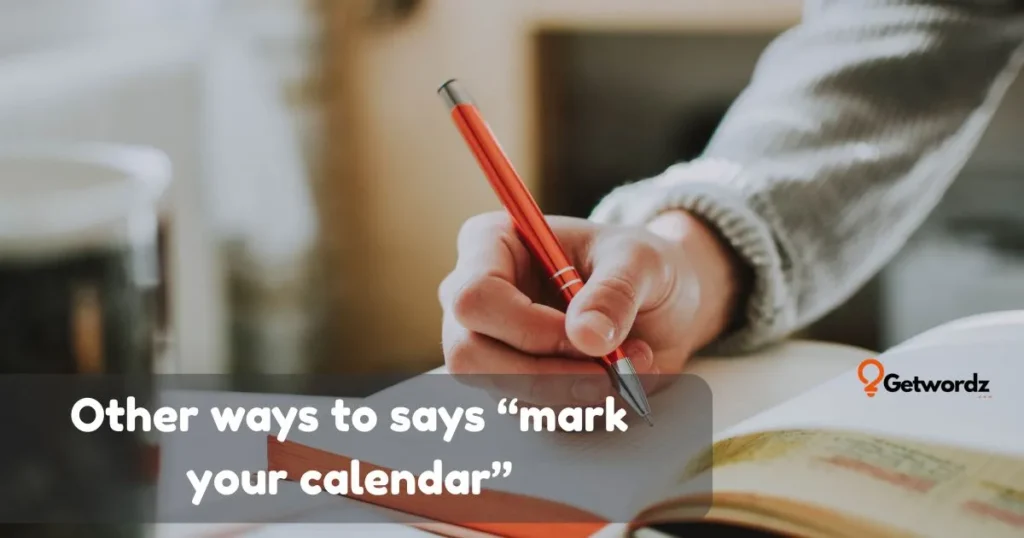“Mark your calendar” is a friendly reminder we often use to help others remember something important, whether it’s a birthday, meeting, or an exciting event. It instantly creates a sense of anticipation and enthusiasm.
But after hearing it countless times, the phrase can start to feel a little plain or predictable. That’s why so many people look for fresh, creative alternatives that sound more genuine and engaging.
If you’ve ever wanted to remind your friends, coworkers, or family members about something special without sounding repetitive, you’re in the right place.
Whether you’re sending a fun text about a weekend plan, inviting your partner to a date night, or reminding your team about a big presentation, using unique expressions or better wording can make your message feel more personal and memorable.
Based on everyday communication and real-life experiences, this post shares natural, expressive, and creative ways to say “mark your calendar.” Each alternative fits a different tone or situation, fun, professional, warm, or casual, so you’ll always have the perfect phrase ready for any moment.
Get ready to discover new ways to grab attention and make your reminders stand out. Let’s explore the best alternatives to mark your calendar that people will actually remember.
1. Save the Date
Scenario: You’re planning a wedding, a product launch, or even a virtual event and want to make sure everyone remembers the big day.
Explanation: “Save the date” is one of the most classic and formal alternatives to mark your calendar. It’s often used in event invitations, emails, and announcements to create excitement and anticipation.
Examples:
- Save the date for our annual charity dinner on May 10th!
- We can’t wait to see you, save the date for our new product reveal.
- Save the date! Big things are coming next month.
Why It Works: This phrase feels polished and professional yet warm enough for personal use. It’s short, catchy, and instantly creates a sense of importance around the event.
2. Don’t Miss It
Scenario: You’re reminding friends about an upcoming concert or coworkers about a key meeting.
Explanation: “Don’t miss it” is a direct, energetic, and conversational phrase that emphasizes urgency. It’s a great creative alternative to mark your calendar when you want to grab attention fast.
Examples:
- Our Friday happy hour starts at 6, don’t miss it!
- Don’t miss it, this workshop could change how you approach teamwork.
- The biggest sale of the year starts tomorrow, don’t miss it!
Why It Works: It adds enthusiasm and energy, creating a sense of FOMO (fear of missing out). Perfect for social media, invites, and casual reminders.
3. Set a Reminder
Scenario: You’re telling a friend or colleague to make sure they remember a deadline or event.
Explanation: “Set a reminder” feels practical and tech-savvy. It’s a better way to say mark your calendar when addressing a digital audience or referencing phone notifications.
Examples:
- Set a reminder for the meeting at 10 a.m.
- Don’t forget, set a reminder for Mom’s birthday lunch.
- Set a reminder to grab your early-bird tickets.
Why It Works: It fits perfectly in a digital age where most of us rely on phones for scheduling. It’s concise, modern, and adaptable to both personal and professional contexts.
4. Circle the Date
Scenario: You’re planning a family get-together or community event and want to make it sound lighthearted.
Explanation: “Circle the date” is a fun, visual alternative to mark your calendar. It creates a nostalgic image of literally circling dates on a paper calendar.
Examples:
- Circle the date, our annual family BBQ is back!
- Circle the date, bestie! Girls’ trip is happening!
- Circle the date for our next town hall meeting.
Why It Works: It adds charm and warmth while keeping the tone casual. People instantly visualize the action, which makes it memorable.
5. Keep the Day Free
Scenario: You’re inviting friends to an outing or letting someone know they’ll need to be available.
Explanation: “Keep the day free” sounds friendly, thoughtful, and slightly informal. It’s ideal for social gatherings or personal invitations.
Examples:
- Keep the day free, we’re celebrating your promotion!
- Keep the day free for a surprise trip.
- Hey, keep the day free! You’ll thank me later.
Why It Works: It feels considerate and personal. You’re not just reminding someone; you’re helping them make space for something special.
6. Jot It Down
Scenario: You’re talking to a coworker or classmate about an upcoming task or event.
Explanation: “Jot it down” is a casual and conversational way to say mark your calendar. It suggests quick note-taking and helps ensure people don’t forget.
Examples:
- Jot it down, presentation review on Thursday.
- Jot it down before you forget, dinner at my place Saturday.
- Better jot it down now; it’s going to be epic.
Why It Works: It’s relaxed, friendly, and works in both written and spoken communication. It sounds natural and relatable.
Read More: Other Ways to Say “You got this” with Examples!
7. Pencil It In
Scenario: You’re suggesting plans that aren’t fully confirmed yet but likely to happen.
Explanation: “Pencil it in” is a polite, flexible phrase that implies tentative scheduling. It’s a unique expression perfect for business or casual use.
Examples:
- Let’s pencil it in for next Tuesday.
- Can we pencil you in for the interview?
- Pencil it in, plans may shift, but that’s the target date.
Why It Works: It communicates commitment while leaving room for adjustment, making it ideal for evolving plans.
8. Don’t Forget the Date
Scenario: You’re sending a friendly reminder about something important like a reunion or appointment.
Explanation: This phrase is warm, clear, and human. It’s better to mark your calendar when you want a touch of sincerity.
Examples:
- Don’t forget the date, your favorite band’s coming to town!
- Don’t forget the date, we’re meeting the new client.
- Don’t forget the date of your big presentation!
Why It Works: It feels personal and caring, reminding someone that you genuinely want them to remember.
9. Make a Note of It
Scenario: You’re organizing plans, tasks, or upcoming events with a friend or coworker.
Explanation: “Make a note of it” is calm, polite, and slightly formal. It’s great for professional settings or well-written messages.
Examples:
- Make a note of it, training starts on the 15th.
- Make a note of it, we’ll discuss this again later.
- Make a note of it so you don’t double-book.
Why It Works: It’s efficient and polite, blending professionalism with everyday ease.
10. Lock It In
Scenario: You’re confirming plans, dates, or schedules in a confident, enthusiastic tone.
Explanation: “Lock it in” is a dynamic and modern alternative to mark your calendar. It conveys finality and excitement.
Examples:
- Lock it in, Friday night is game night!
- Let’s lock in the date before everyone gets busy.
- Lock it in, we’re all set for launch day.
Why It Works: It sounds confident and definitive, perfect for team environments or energetic announcements.
11.Put It on Your Calendar
Scenario: You’re reminding your team or friends to add an event to their planner or phone calendar.
Explanation: “Put it on your calendar” is a straightforward and reliable alternative to mark your calendar. It’s practical and fits well in both personal and professional conversations.
Examples:
- Put it on your calendar, team lunch this Friday.
- Don’t forget to put it on your calendar; the webinar starts at noon.
- Go ahead and put it on your calendar before it slips your mind.
Why It Works: It’s direct, clear, and instantly understood. This phrase keeps communication simple while ensuring the message sticks.
12. Reserve the Day
Scenario: You’re planning a special celebration or asking someone to keep their schedule open for an event.
Explanation: “Reserve the day” adds a touch of elegance and formality to your reminder. It’s a creative alternative perfect for weddings, ceremonies, or professional gatherings.
Examples:
- Please reserve the day for our engagement celebration.
- Reserve the day, our company’s anniversary party is around the corner.
- Reserve the day for something unforgettable.
Why It Works: It conveys respect and significance. This phrasing feels polished while creating a sense of anticipation and exclusivity.
13. Hold the Date
Scenario: You’re notifying someone about an important date that’s still being finalized but should be kept free.
Explanation: “Hold the date” is often used for event previews or early announcements. It’s a unique expression that builds anticipation while reserving time in advance.
Examples:
- Hold the date for our upcoming community fair!
- Please hold the date, details to follow soon.
- Hold the date for a surprise event you won’t want to miss.
Why It Works: It strikes a perfect balance between formal and friendly, signaling that something meaningful is coming up.
14. Save Some Time For Us
Scenario: You’re inviting a friend, client, or colleague to participate in something special or personal.
Explanation: “Save some time for us” feels warm, thoughtful, and inviting. It’s a different way to say mark your calendar while sounding more personal and emotional.
Examples:
- Save some time for us this weekend, we’ve got something fun planned.
- Save some time for us at the conference.
- Save some time for us during your next visit.
Why It Works: It adds a human touch, blending friendliness with gentle persuasion. It’s perfect for informal invitations or warm professional messages.
15. Put a Pin in It
Scenario: You’re tentatively scheduling something or asking someone to keep a date in mind.
Explanation: “Put a pin in it” is modern and conversational. It works as a creative phrasing for marking tentative plans without committing fully.
Examples:
- Let’s put a pin in it for next week and confirm later.
- Put a pin in it, we’ll revisit this after the meeting.
- Can you put a pin in that date for now?
Why It Works: It’s trendy, flexible, and feels natural in both casual and workplace settings. It implies interest without pressure.
16. Make It a Date
Scenario: You’re confirming plans with a friend, partner, or family member in a cheerful tone.
Explanation: “Make it a date” is friendly, confident, and flirty when used in the right context. It’s a fun alternative that makes any event sound exciting.
Examples:
- Saturday brunch? Make it a date!
- Let’s make it a date and finally catch up.
- Make it a date, we’re long overdue for some fun.
Why It Works: It’s lively and engaging, adding enthusiasm and personal energy to your message.
17. Add It to Your Planner
Scenario: You’re reminding someone who loves organization or uses planners and scheduling apps.
Explanation: “Add it to your planner” is a better wording for marking your calendar that sounds proactive and structured.
Examples:
- Add it to your planner, team training starts on Monday.
- Don’t forget to add it to your planner before the week fills up.
- Add it to your planner and set a reminder just in case.
Why It Works: It’s practical and modern, ideal for professionals or productivity lovers. It signals efficiency and reliability.
18. Block the Day
Scenario: You’re organizing a meeting, event, or outing and want people to set aside time.
Explanation: “Block the day” is assertive yet friendly, often used in corporate or team communication. It’s a different way to say mark your calendar that prioritizes scheduling clarity.
Examples:
- Block the day, annual strategy meeting ahead.
- Please block the day for our leadership workshop.
- Block the day and bring your ideas!
Why It Works: It conveys importance and helps prevent scheduling conflicts, especially in professional environments.
19. Keep That Date Open
Scenario: You’re inviting someone to something fun and want them to remain flexible.
Explanation: “Keep that date open” is casual, conversational, and slightly suspenseful. It’s great for personal invites or surprise events.
Examples:
- Keep that date open, we’ve got something planned for you.
- Keep that date open; details coming soon!
- Keep that date open, it’s going to be a blast.
Why It Works: It sparks curiosity and excitement while keeping the tone relaxed and friendly.
20. Remember the Date
Scenario: You’re making sure someone won’t forget a meaningful or important day.
Explanation: “Remember the date” is clear, emotional, and sincere. It’s a simple but powerful alternative to mark your calendar for sentimental occasions.
Examples:
- Remember the date, we met exactly one year ago.
- Remember the date, the concert starts at 8 sharp.
- Remember the date, it’s when everything changes.
Why It Works: It feels heartfelt and memorable, ideal for personal messages or emotional events.
21. Highlight the Date
Scenario: You’re sharing an announcement or event in a visually engaging way.
Explanation: “Highlight the date” adds a creative, modern twist. It’s often used in digital communication to emphasize importance.
Examples:
- Highlight the date, our next big update drops soon!
- Highlight the date for our new collection launch.
- Highlight the date and spread the word.
Why It Works: It stands out visually and verbally, making it perfect for marketing, social media, or newsletters.
22. Schedule It In
Scenario: You’re helping someone plan their busy week or set time for a specific event.
Explanation: “Schedule it in” is practical and assertive. It’s a useful alternative for those who like clarity and planning.
Examples:
- Schedule it in before your calendar fills up.
- Let’s schedule it in and make it happen.
- Schedule it for Thursday afternoon.
Why It Works: It’s direct and actionable, ensuring tasks and events get prioritized.
23. Take Note of the Date
Scenario: You’re sharing a formal event announcement or update.
Explanation: “Take note of the date” sounds polished and respectful. It’s a refined alternative ideal for written communication.
Examples:
- Take note of the date, registration closes soon.
- Please take note of the date for our quarterly meeting.
- Take note of the date to avoid any mix-ups.
Why It Works: It’s formal yet clear, suitable for emails, invitations, or official posts.
24. Lock the Day
Scenario: You’re confirming final details for an event or meeting.
Explanation: “Lock the day” is assertive and definitive, making it a strong creative alternative to mark your calendar.
Examples:
- Lock the day, it’s our annual retreat.
- Let’s lock the day and finalize the plan.
- Lock the day, everything’s confirmed.
Why It Works: It shows commitment and confidence, signaling that the date is fixed and important.
25. Plan Around It
Scenario: You’re letting someone know they’ll need to adjust their schedule for something significant.
Explanation: “Plan around it” is flexible, conversational, and practical. It helps others prioritize the event.
Examples:
- Plan around it, this workshop is a must-attend.
- Plan around it so you don’t double-book.
- Plan around it, it’s the highlight of the month.
Why It Works: It acknowledges people’s busy lives while emphasizing importance, making it relatable and respectful.
Read More: Other Ways to say “Hit it and Quit it” with Examples!
26. Save Some Space on Your Schedule
Scenario: You’re requesting time from someone with a packed calendar.
Explanation: “Save some space on your schedule” is thoughtful and polite. It’s a better way to say mark your calendar in formal or business contexts.
Examples:
- Save some space on your schedule for our client meeting.
- Save some space on your schedule next week, we’ll need your input.
- Save some space on your schedule for something exciting.
Why It Works: It’s respectful and professional, showing appreciation for others’ time.
27. Jot the Date
Scenario: You’re casually mentioning an event during a quick chat or text.
Explanation: “Jot the date” is short, informal, and spontaneous. It’s a creative expression that feels effortless.
Examples:
- Jot the date, we’re hosting a surprise dinner.
- Jot the date before it slips your mind.
- Jot the date, it’s going to be worth it.
Why It Works: It’s quick and friendly, perfect for casual communication with peers or friends.
28. Bookmark the Day
Scenario: You’re announcing a digital or online event like a webinar or livestream.
Explanation: “Bookmark the day” fits perfectly in the online world. It’s a unique expression that blends modern habits with the reminder concept.
Examples:
- Bookmark the day, our livestream starts at 5!
- Bookmark the day and join us for an exclusive demo.
- Bookmark the day for the big reveal.
Why It Works: It’s clever, digital-friendly, and catchy, ideal for online promotions or reminders.
29. Stick It on Your Schedule
Scenario: You’re sending a casual or humorous reminder to a friend or coworker.
Explanation: “Stick it on your schedule” is playful and modern. It’s a fun alternative that adds personality to your reminder.
Examples:
- Stick it on your schedule, karaoke night’s back!
- Stick it on your schedule before you forget.
- Stick it on your schedule, you don’t want to miss this.
Why It Works: It adds humor and a lighthearted tone, making reminders more engaging and memorable.
30. Don’t Let It Slip
Scenario: You’re giving a gentle, friendly reminder about an event or task.
Explanation: “Don’t let it slip” is informal and relatable. It’s a different way to say mark your calendar that feels natural in conversation.
Examples:
- Don’t let it slip, we’ve got dinner plans on Friday.
- Don’t let it slip; it’s your last chance to register.
- Don’t let it slip, our big reveal happens tomorrow.
Why It Works: It sounds caring and real, showing that you want the person to stay on track without sounding pushy
✅ Pros and cons⚠️of Using Mark Your Calendar
pros✅
- 🗓️ Highly Recognizable Phrase – People instantly understand what “mark your calendar” means making it clear and engaging
- 🌍 Versatile Usage – Works well in personal professional and promotional contexts whether it’s for events meetings or announcements
- 🔍 Strong Search Intent – Commonly searched by users looking for reminders or creative alternatives which helps boost SEO visibility
- 💫 Emotionally Engaging – Creates anticipation and excitement encouraging people to take action or remember a specific date
- 🧭 Perfect for Headlines & CTAs – The phrase grabs attention fast and motivates readers to register join or participate.
⚠️ Cons
- 😕 Overused Expression – Because it’s so common it can sound repetitive or generic
- 🏢 Limited Formality – Might feel too casual for formal or executive-level communication
- 📉 Not Always SEO-Distinctive – High competition can make ranking for it more difficult
- 💬 Can Lack Personal Touch – Compared to unique alternatives it may sound impersonal
- 🎯 Context-Sensitive – Works best for event-related content and less effective in other niches
Closing words
Finding better ways to mark your calendar helps you sound more creative and intentional in every message. These fresh alternatives and unique expressions keep your communication lively while avoiding repetitive or overused wording. Each phrase adds a touch of personality and warmth that fits different tones and occasions.
Whether you’re sending a reminder to friends, planning something with colleagues, or posting on social media, these creative alternatives give your words a fresh and memorable spark.
Try using one of these phrases in your next invitation or note, it’s a simple way to make your message stand out. Thoughtful wording always leaves a lasting impression. So go ahead, explore new ways to say it, and make every moment worth marking on your calendar.




